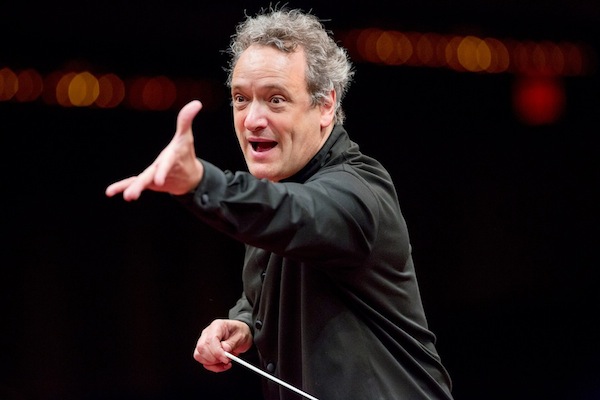A mixed Mostly Mozart program finds its tempo giusto
Tuesday night’s Mostly Mozart Festival Orchestra concert at Avery Fisher Hall was Mozart, mostly, plus his good friend Haydn. Add a little superfluous, postmodern glue to complete the task of sticking them together, and the result was flawed but, mostly, enjoyable.
The glue—Alfred Schnittke’s Moz-Art à la Haydn—opened the concert. Schnittke’s music is always a welcome surprise, as was the dramatic staging for the performance. The lights were turned down to candle level, and the quiet, ghostly lines materialized out of the darkness. The filaments of music and light grew into a a piece before the audience’s eyes.
Subtitled “Play on music,” it’s one of the most compact examples of Schnittke’s mature aesthetic: the sound of a composer waking up from the long, unpleasant dream of Soviet communism to discover the overabundance of Western classical music, determined to stuff every new discovery into his compositions.
Fronted by two violin soloists (Ruggero Allifranchini and Laura Frautschi), each leading a small complement of strings, bits of Mozart and Haydn rise out of the abstract ensemble textures. After a burst of weird, but recognizable, sturm und drang, fragmented lines chase each other around the page, slipping in and out of dissonances and cadences. The soloists physically badger the other violinists across the stage, and the piece ended with all the violinist walking off the stage, playing in gradual diminuendo, while the lights went dark.
But this intelligent program choice and staging was let down by a lack of clear purpose from conductor Louis Langrée. Schnittke’s sense of organization is unconventional, and just playing the notes, as on Tuesday, does him the disservice of making him sound like a pasticheur—his logic is clear, but not classical.
Christian Tetzlaff had a related problem in the opening movement of Mozart’s Violin Concerto No. 1, K. 207—he played the notes, but with such a headlong rush that he didn’t give himself time to make sense of them, or even offer coherent thinking. It’s a soloist’s prerogative to play with expressive freedom, but either by choice or accident Tetzlaff’s main interpretive gesture was impetuosity; after the first time through the main theme, his playing started to fatigue the ear, and his articulations were often one long smear.
Tetzlaff played his own cadenza, which had a solid but unmemorable grasp of harmonies of the classical era. But in the second movement, both warmed up and having caught his breath, he played clearly and elegantly inside the music, and it was lovely. The fast finale was utterly different than the first movement, every note as clear as a bell, tempos sharp and expressive. His cadenzas were more distinctive, intelligent and satisfying. By the end, the good far outshone the bad, and the encore of Mozart’s Rondo in C Major, K. 373 was sweet.
The orchestra and Langrée opened the second half with terrific playing of Haydn’s quirky, excellent Overture to his opera L’isola disabitata. The playing was refined and effectively objective in the eerie, quiet stretches, intense and muscular in the dramatically fast passages. The Festival Orchestra plays modern instruments, but they bring period performance ideas about tempos and articulations, and play with a verve that surpasses most early music groups.
The orchestra had a full, colorful sound for the overture and the concluding work, Mozart’s Symphony No. 38, “Prague.” One of his finest symphonies, it has more gravity than most and a stately elegance that makes it attractive and fresh. This is music where just playing the notes, and playing them with beautiful ensemble sound, clearly made rhythms, and satisfying tempos, is most of what is needed to produce a satisfying performance.
There were a few flubs and slips, but the playing was spirited and musical, eliciting applause after each movement. The orchestra played the opening of the final movement with a feather-light articulation that stood out in memory. Tempos were ideal throughout, the fast movements brisk without being hectic, and the Andante movement flowed with a casual, strolling pace.
The size of the orchestra—larger than a chamber group but much smaller than a modern ensemble—seems perfect for this music, as every but of internal counterpoint and antiphony was clear. Langrée, his Mostly Mozart contract just renewed through 2017, is well-loved by his audience and was at his best in the second half: implicitly thoughtful, motivated and assured.
The Mostly Mozart Festival Orchestra repeats this program 8 p.m. Wednesday at Avery Fisher Hall mostlymozart.org.







